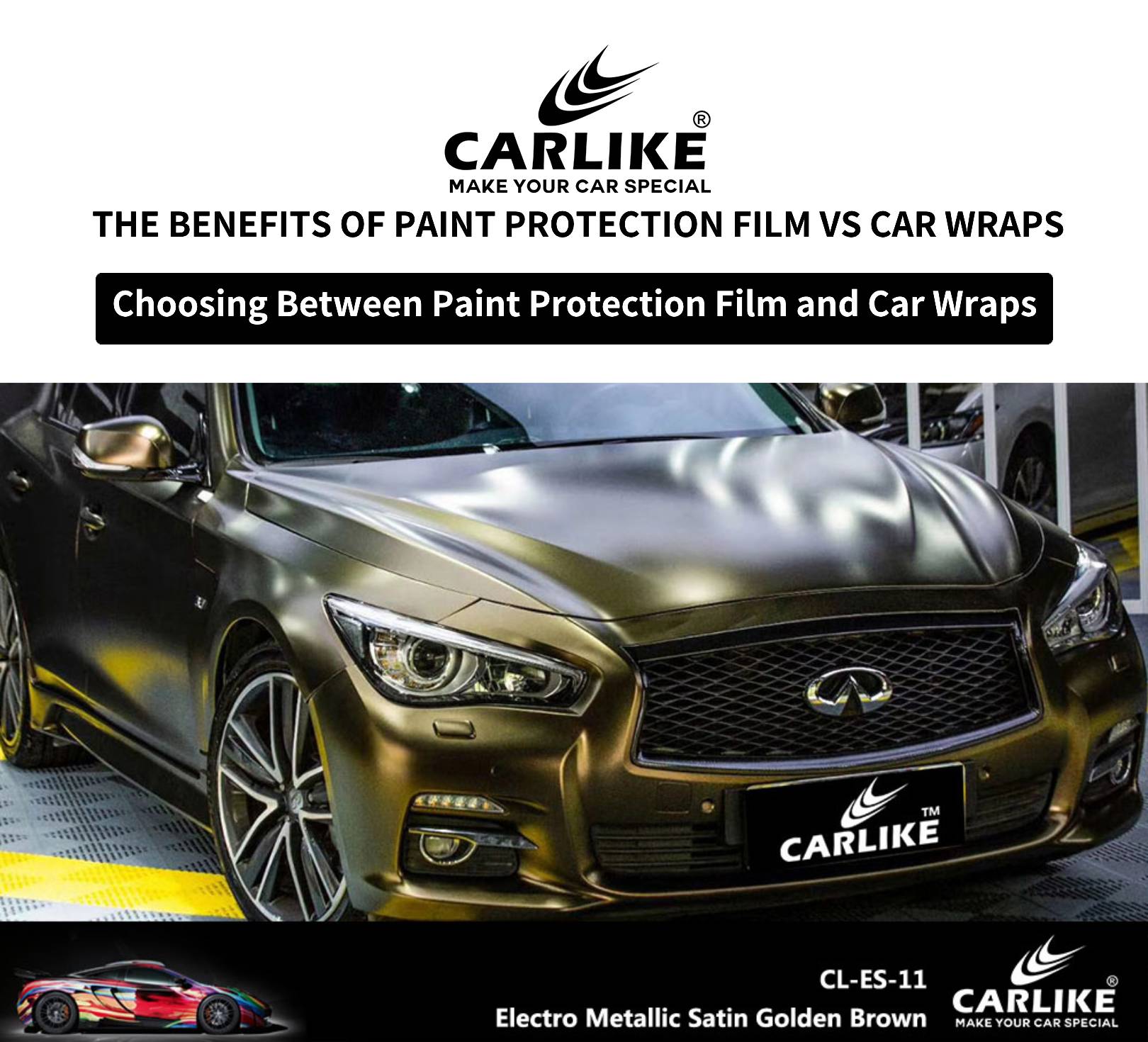Introduction
Car wraps are large vinyl decals or films applied to the exterior of a vehicle, covering its original paint. They come in various colors, finishes, and designs, allowing car owners to customize their vehicles without permanent alterations. Over the years, car films have gained popularity due to their versatility, ease of application, and affordability compared to traditional paint jobs. Many car enthusiasts and businesses use them for advertising, personalization, or simply to protect their vehicles.
Protecting a vehicle's paint from environmental factors is essential for maintaining its appearance and value. Sun exposure, rain, dirt, road salt, bird droppings, and other elements can cause paint to fade, chip, or corrode over time. Without proper protection, these damages can lead to costly repairs and diminish the vehicle’s aesthetic appeal.
Key benefits of car wraps for paint protection include:
- UV and weather resistance : Car wraps act as a shield against harmful UV rays, moisture, and extreme weather conditions.
- Scratch and abrasion protection : The vinyl layer can help prevent minor scratches and abrasions, preserving the paint underneath.
- Cost-effective preservation : Wrapping a vehicle is more affordable than frequent paint touch-ups or repairs, and it extends the paint’s lifespan.
Common Environmental Hazards to Car Paint
1. Sunlight (UV Rays)
Prolonged exposure to sunlight, specifically ultraviolet (UV) rays, can cause significant damage to a car’s paint. UV rays break down the chemical bonds in paint, leading to fading and oxidation over time. As the protective clear coat degrades, the paint becomes dull and loses its vibrant color. Cars parked outdoors for extended periods, especially in sunny climates, are more susceptible to this type of damage.
2. Rain and Moisture
Rain, particularly acid rain, can harm a car’s finish. Acid rain occurs when pollutants like sulfur dioxide and nitrogen oxides in the atmosphere mix with rainwater. When this acidic water lands on a car, it can slowly eat away at the clear coat and expose the paint to the elements, causing discoloration and erosion. Additionally, moisture from rain or humidity can lead to rust formation if the paint layer is compromised.
3. Dust, Dirt, and Debris
Dust and dirt particles can seem harmless, but over time, they can cause wear on a car’s paint. When these particles accumulate on the surface, they act like abrasive materials. If the car is washed or wiped without proper care, the dust can create small scratches that diminish the shine and smoothness of the paint. Flying debris, such as gravel or sand, can chip or scratch the paint, leading to more extensive damage if left untreated.
4. Bird Droppings and Tree Sap
Bird droppings and tree sap are highly acidic and can cause significant damage to car paint. Bird droppings, in particular, can quickly corrode the clear coat and leave unsightly stains. If not removed promptly, the acidity can even eat through layers of paint. Tree sap hardens over time, becoming difficult to remove and potentially pulling off paint when scraped or cleaned. Both substances need immediate attention to prevent lasting damage.
How Car Wraps Provide Protection
How Car Wraps Provide Protection
Car wraps offer a range of protective benefits beyond their aesthetic appeal. Here's a closer look at how they safeguard your vehicle's paint:
UV Protection
One of the key benefits of a car wrap is its ability to shield the vehicle’s paint from harmful UV rays. Prolonged exposure to sunlight can cause paint to fade and lose its vibrancy. A car wrap acts as a protective barrier, absorbing UV radiation and keeping the original paint beneath it from deteriorating, ensuring the vehicle maintains its fresh look over time.
Weather Resistance
Car wraps also provide a strong layer of defense against harsh weather conditions. They shield the vehicle from rain, moisture, snow, and even extreme heat. This weather resistance helps protect the underlying paint from corrosion, rust, and other weather-related damage, extending the lifespan of the vehicle's exterior.
Physical Protection
A car wrap serves as a physical barrier between the car's paint and external elements like road debris, small rocks, and other hazards that can cause chips and minor scratches. While the wrap may sustain some damage, it preserves the paint underneath, which can save you from costly touch-ups or repairs.
Chemical Protection
Car wraps also guard against chemical contaminants that can damage the paint, such as bird droppings, tree sap, and pollutants. These substances can etch into a car’s surface if left untreated, but the wrap provides an easy-to-clean layer that resists staining, ensuring the original paint remains untouched by harmful chemicals.
In summary, car wraps not only enhance the appearance of a vehicle but also serve as a multi-functional protective layer against UV rays, harsh weather, physical damage, and chemical contaminants.
Additional Benefits of Car Wraps
Cost Savings:
One of the key advantages of using car wraps is the potential for significant cost savings. Unlike traditional paint jobs, which may require frequent touch-ups or repainting to maintain their appearance, wraps act as a protective barrier. This reduces the need for paint repairs caused by fading, scratches, or environmental wear. Over time, the durability of a quality wrap helps drivers avoid the high costs of repainting, making it a more economical solution in the long run.
Customization and Aesthetic Appeal:
Car wraps offer unmatched flexibility when it comes to customization. Whether you want a sleek, modern look or something bold and creative, wraps allow you to transform your vehicle's appearance while providing protection. You can choose from various colors, finishes, and patterns, all without altering the car’s original paint. This dual benefit of customization and protection makes wraps a popular choice for personalizing vehicles.
Easy Maintenance:
Car wraps simplify the process of keeping your vehicle looking clean and polished. Unlike paint, which can show swirls, chips, or oxidation over time, wraps are low-maintenance and resilient. They are easier to clean, typically requiring only a simple wash with mild soap and water, and they help protect against dirt and grime buildup. Additionally, wraps are resistant to UV rays, helping maintain their vibrant appearance for longer durations.
Long-Term Durability and Maintenance
High-quality car wraps are designed to last several years, typically ranging from 5 to 7 years, depending on factors such as the brand of wrap, installation quality, and how well the vehicle is maintained. When properly cared for, a high-quality wrap can protect your vehicle’s paint while maintaining a vibrant and polished appearance throughout its lifespan.
The key to maximizing the longevity of your car wrap is proper maintenance. Regularly washing the vehicle with a mild, non-abrasive soap, avoiding harsh chemicals, and parking in shaded areas can significantly extend the wrap’s lifespan. It's also advisable to avoid high-pressure washes and automatic car washes that could cause damage to the wrap’s surface. By following these guidelines, you can keep the wrap in great condition, ensuring that it continues to protect the paint beneath.
One of the major benefits of using a car wrap is its flexibility. Wraps can be easily replaced or removed without damaging the vehicle’s original paint, making them an excellent choice for vehicle owners who want to update the look of their car or protect their paintwork without permanent changes. This makes wraps an attractive, cost-effective option for maintaining both the aesthetic appeal and value of your car.





